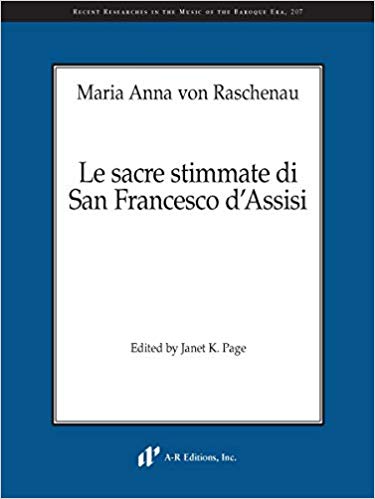Edited by Janet K. Page
Recent Researches in the Music of the Baroque Era, 207
xxxviii, six plates, 92pp
ISBN 978-1-9872-0255-7 $180
One of seven similar works known by the composer, Le sacre stimmate di San Francesco d’Assisi was performed to Emperor Leopold I on St James day at the convent of that name in Vienna. The eight characters (SSSATTTB voices for St Francis, Christ, the narrator and five seraphim) are allocated arias, duets, trios and choruses, interspersed with secco recitative (and some arioso). The writing is melodic if rather brief (though not dissimilar to music by Bertali and Schmelzer for the Imperial court chapel, so perhaps that says more about the emperor’s preferences?) The voices are accompanied by a string group; the editor has chosen to interpret “viole” has violas da gamba and curiously (to my mind, at least) decided to number them 1-3, although the two numbers for which they are specified in only use two, albeit in different clefs. I would question the idea of someone sitting around with their soprano-clef viola, waiting just to play in one movement. Such a level of prescription when there is none in the source strikes me as counterintuitive. Likewise, I see no mention in the (detailed and highly interesting) introduction of that fact that the top violin and the top viola parts pretty much double one another an octave apart for most of the time – which, in turn, largely double the alto part. As the only musical source is a score copied by an imperial scribe (apparently Leopold liked to follow the music as he listened), its authority is dubious and this quirk ought as least to have been mentioned. I absolutely take my hat off to Janet K. Page for meticulously tracking down almost all of the Biblical references given in the printed libretto; while I’m not sure that Latin was absolutely essential, and I’m not 100% convinced that modern performers require such background when the editor has also provided a beautiful translation of the sung Italian text, it shows an exemplary thoroughness. As far as the edition goes, it is laid out in traditional A-R format and follows (broadly) their usual editorial approach. The only thing that I don’t particularly like about that is the tacit suppression of original accidentals; retaining them would have made challenging the dubious D flats in bar 41 on page 41 more difficult (as it is, if there were no flat on the penultimate note of the previous bar, I would have probably added an editorial natural at that point!), and on page 50, surely the brackets in the continuo part are superfluous, since the pitch of the note continues over the barline. But these are very, very small points in a thoroughly excellent edition. I hope performers will be encouraged to investigate this largely unknown part of Hapsburg music history.
Brian Clark
Click HERE to buy the score on amazon.com.
